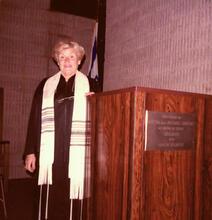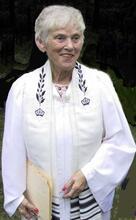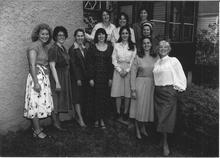Betty Robbins
As a child in Poland, Betty Robbins spent six years as the soloist in her synagogue’s boys’ choir. She also convinced another synagogue to let her study in their religious heder. In Australia in 1943, Robbins married a corporal in the U.S. Army Air Corps, and in 1951 the couple moved to Oceanside, New York. They became members at Temple Avodah, and in 1955 the Board of Trustees unanimously appointed Robbins as their cantor. Robbins is often heralded as the first female cantor – in fact, that honor goes to Julie Rosewald. However, Robbins was the first woman to be officially designated as cantor, and her story made front-page news in The New York Times in 1955. She spent the rest of her life serving as cantor in various congregations and teaching religious school.
Amid great worldwide controversy, Betty Robbins became the first woman to be ordained as a cantor. She was officially appointed as the cantor of Temple Avodah in Oceanside, New York by the Board of Trustees and Congregation in July 1955. At the age of thirty-one, Betty Robbins, with four young children, her husband, and a new homeland, shattered five thousand years of Jewish tradition and history when she was officially designated a cantor. The first woman to serve as a cantor was Julie Rosewald (1847-1906), who unofficially served as Temple Emanu-El’s cantor in San Francisco from 1884 to 1893. Robins followed in Rosewald’s footsteps, becoming one of the first women to wear the garb and perform the traditional role of Synagogue cantorhazzan (cantor) in a Jewish synagogue.
Childhood in Poland
Betty Robbins was born Berta Abramson on April 9, 1924, in Cavala, Greece, to Russian parents Ida (Nathanson) and Samuel Abramson. In 1928 the Abramsons moved with their daughter and older son Moishe to Sopot, Poland, where Samuel Abramson went into business with relatives. Inspired by recordings of the great cantor Yossele Rosenblatt, Betty dreamed of joining the boys’ choir in the German Jewish synagogue she attended. When the cantor refused to permit Betty to sing in the boys’ choir during services, she decided to sit opposite the choir in the upstairs balcony and try to out-sing them. Eventually the cantor agreed to teach Betty and allow her to sing if she would cut her braids off and wear a simple boy’s haircut. Betty was soloist in the choir of the synagogue for six years, until 1938. She also dared to enter the religious heder of the Polish Synagogue of Sopot. Again the rabbi relented and allowed her to study, provided that she sat in the hallway behind a curtain during the lessons.
In 1938 the family went into hiding for many months. Moishe Abramson had already left Poland in 1933 as a young Zionist and emigrated to Palestine. Betty’s father finally managed to arrange the family’s escape. After some time in London, Samuel Abramson was offered an opportunity to immigrate to Australia or Madagascar. He chose Australia because the city of Sydney sounded Jewish to him.
Moving to the United States
In April 1942, at a dance arranged by Rabbi Max Schenk at Temple Emanuel in Sydney, Betty met Sheldon Robbins, a corporal in the medical division of the U.S. Army Air Corps who was on leave from his New Guinea station. They were married in a civil ceremony in Mackay, Queensland, on September 18, 1943 and in a religious ceremony at the Brisbane Hebrew Congregation, Queensland, on October 25, 1943. On August 8, 1944, Betty Robbins came to the United States on the first boat transporting war brides from Australia.
After the war, Sheldon Robbins began working for the New York City health department. Judd Robbins was born in 1946, Sandra Robbins in 1949, Jacqueline Robbins in 1950, and Steven Robbins in 1954. Around 1951, the Robbins family moved to Oceanside, New York, where they became members of the Reform Jewish congregation of Temple Avodah.
In 1955 Temple Avodah was without a cantor for the High Holidays. After much consultation with their rabbi, Charles Ozer, and other eminent Jewish authorities, the Board of Trustees in August unanimously appointed Betty Robbins the new cantor of this congregation.
A front-page article in the New York Times on August 3, 1955, states, “A spokesman for the School of Sacred Music of Hebrew Union College-Jewish Institute of Religion said she might well be the first woman cantor in 5,000 years of Jewish history.” The article continues, “The spokesman for the School of Sacred Music, founded in 1947 as the first training school for cantors in this country, said today there was no religious law, merely a tradition, against women becoming cantors.”
Career
Robbins taught religious school for eighteen years at Sinai Reform Temple in Bay Shore, Long Island, and earned a teaching certificate from Hebrew Union College in 1962. She tutored bar and Lit. "daughter of the commandment." A girl who has reached legal-religious maturity and is now obligated to fulfill the commandmentsbat mitzvah students, taught Israeli dancing and formed and directed adult and children’s choirs. As a teacher for the Association for Retarded Children, Robbins used music therapy long before it was recognized as a specialty.
After Sheldon Robbins retired in 1979, he and Betty Robbins moved to Lake Worth, Florida. In Palm Beach County, Betty Robbins served as cantor, tutored bar and bat mitzvah students, taught religious school, organized choirs and created a yearly zimriah (songfest) for schoolchildren. As a member of the clergy, she conducted religious services on dozens of worldwide Jewish holiday cruises.
The little girl from Greece who went all alone in her new homeland, Poland, to hear the cantor sing melodies she loved, was a rebel with a heart and mind of her own. The innate sense of equality and independence that existed inside this eight-year-old became the pioneering spirit of the female cantor Betty Robbins.
On February 19, 2004, Robbins died peacefully at her home in Ashland, Oregon.
“Greek Holocaust Refugee at 16, She Revisits Birth Place, Teaches in U.S.” Jewish Week-American Examiner, February 13–19, 1977
“Making Musical History.” Australian Jewish News, Sydney edition, life/style, April 24, 1992, section 2, 1–2
Robbins, Betty. Interviews and correspondence with author
Temple Topics. Temple Avodah, Oceanside, N.Y., September 1955, October 1955
“Woman Cantor.” Time (August 15, 1955): 36–37
“Woman Named Cantor of Jewish Synagogue.” Long Island Star-Journal,August 2, 1955
“Woman Named Temple Cantor, Perhaps First in Jewish History.” NYTimes, August 3, 1955, 1.






